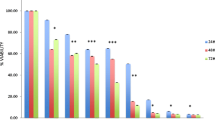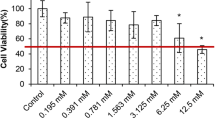Abstract
Recent studies suggested that boron has a chemo-preventive role in prostate cancer. In the present report, we investigated the effects of calcium fructoborate (CF) and boric acid (BA) on activation of the apoptotic pathway in MDA-MB-231 human breast cancer cells. Exposure to BA and CF inhibited the proliferation of breast cancer cells in a dose-dependent manner. Treatment with CF but not BA resulted in a decrease in p53 and bcl-2 protein levels. Furthermore, after the treatment with CF, augmentation of pro-caspase-3 protein expression, cytosolic cytochrome c level, and caspase-3 activity were observed, indicating apoptotic cell death induction. This was also demonstrated by terminal deoxynucleotidyl transferase-mediated 2′-deoxyuridine 5′-triphosphate nick-end-labeling assay. In conclusion, our data provide arguments to the fact that both BA and CF inhibited the growth of breast cancer cells, while only CF induced apoptosis. Additional studies will be needed to identify the underlying mechanism responsible for the observed cellular responses to these compounds and to determine if BA and CF may be further evaluated as chemotherapeutic agents for human cancer.






Similar content being viewed by others
References
Nielsen FH, Mullen LM, Gallagher SK (1990) Effect of boron depletion and repletion on blood indicators of calcium status in humans fed a magnesium-low diet. J Trace Elem Exp Med 3:45–54
Nielsen FH, Gallagher SK, Johnson LK, Nielsen EJ (1992) Boron enhances and mimics some effects of estrogen therapy in postmenopausal women. J Trace Elem Exp Med 5:237–246
Naghii MR, Samman S (1997) The effect of boron supplementation on its urinary excretion and selected cardiovascular risk factors in healthy male subjects. Biol Trace Elem Res 56:273–286
Strittmatter P (1964) Reversible direct hydrogen transfer from reduced pyridine nucleotides to cytochrome b5 reductase. J Biol Chem 239:3043–3050
Rajendran KG, Burnham BS, Sood CA (1994) Spielvogel BF, Shaw BR, Hall IH, Anti-inflammatory and anti-osteoporotic activities of base-boronated nucleosides and phosphate-boronated nucleotides in rodents. J Pharm Sci 83:1391–1395
Belver A, Donaire JP (1983) Partial purification of soluble lipoxygenase of sunflower cotyledons: action of boron on the enzyme and lipid constituents. Z Pflanzenphysiol 109:309–317
Spielberg SP, Butler JD, MacDermot K, Schulman JD (1979) Treatment of glutathione synthetase deficient fibroblasts by inhibiting gamma-glutamyl transpeptidase activity with serine and borate. Biochem Biophys Res Commun 89:504–511
Cui Y, Winton MI, Zhang ZF, Rainey C, Marshall J, De Kernion JB, Eckhert CD (2004) Dietary boron intake and prostate cancer risk. Oncol Rep 11:887–892
Gallardo-Williams MT, Chapin RE, King PE, Moser GJ, Goldsworthy TL, Morrison JP Maronpot RR (2004) Boron supplementation inhibits the growth and local expression of IGF-1 in human prostate adenocarcinoma (LNCaP) tumors in nude mice. Toxicol Pathol 32:73–78
Reed J (1999) Dysregulation of apoptosis in cancer. J Clin Oncol 17:2941–2953
Miljkovic D (2000) US patent 6,080,425 (issued June 27, 2000)
Bradford MM (1976) A rapid and sensitive method for the quantitation of microgram quantities of protein utilizing the principle of protein-dye binding. Anal Biochem 72:248–254
Lee YJ, Chen JC, Amoscato AA, Bennouna J, Spitz DR, Suntharalingam M, Rhee JG (2000) Protective role of Bcl2 in metabolic oxidative stress-induced cell death. J Cell Sci 114:677–684
Gross A, McDonnell JM, Korsmeyer SJ (1999) Bcl-2 family members and the mitochondria in apoptosis. Genes Dev 13:1899–1911
Lacroix M, Toillon RA, Leclercq G (2006) p53 and breast cancer, an update. Endocr-Relat Cancer 13:293–325
Haupt S, Berger M, Goldberg Z, Haupt Y (2003) Apoptosis—the p53 network. J Cell Sci 116:4077–4085
Barranco WT, Eckhert CD (2004) Boric acid inhibits humane prostate cancer cell proliferation. Cancer Lett 216:21–29
Barranco WT, Eckhert CD (2006) Cellular changes in boric acid-treated DU-145 prostate cancer cells. Br J Cancer 94:884–890
Chen F, Chang D, Goh M, Klibanov SA, Ljungman M (2000) Role of p53 in cell cycle regulation and apoptosis following exposure to proteasome inhibitors. Cell Growth Differ 11:239–246
Shirangi TR, Zaika A, Moll UM (2002) Nuclear degradation of p53 occurs during down-regulation of the p53 response after DNA damage. FASEB J 16(3):420–422
Author information
Authors and Affiliations
Corresponding author
Rights and permissions
About this article
Cite this article
Scorei, R., Ciubar, R., Ciofrangeanu, C.M. et al. Comparative Effects of Boric Acid and Calcium Fructoborate on Breast Cancer Cells. Biol Trace Elem Res 122, 197–205 (2008). https://doi.org/10.1007/s12011-007-8081-8
Received:
Accepted:
Published:
Issue Date:
DOI: https://doi.org/10.1007/s12011-007-8081-8




